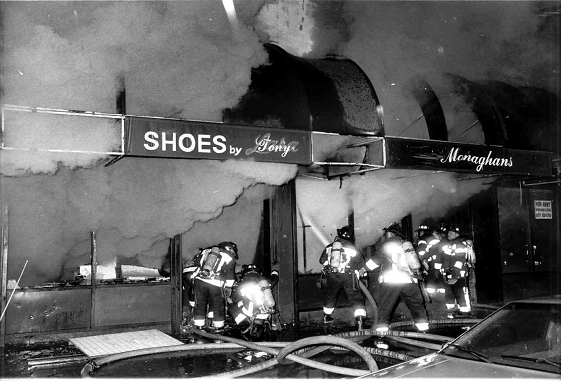Promotional Scenario #13
Promotional Scenario #13
Taxpayer Fire
Oral Assessment exercise:
At 04:30 hours on a cold March morning, you are dispatched to a reported fire at 220 Madison Ave. The building located at 220 Madison Ave. is a 1-story row of stores constructed of Class 3/Ordinary design. Within the row, there are 6 attached stores ranging from a Deli, Shoe store, Monaghan’s restaurant, Art store, a Dry Cleaner to a Antique shop. Each store has an HVAC unit on the roof with a 2 foot high cockloft extending over the entire row of stores. Each store measures approximately 30 x 60.
Upon your arrival, you observe fire showing through the front display windows of the restaurant, with heavy smoke showing from the Shoe store. You respond with 2 Engine Co.s, 1 Ladder Co. and a BC. You are the first arriving FD Unit.
QUESTIONS:
- As the Incident Commander, how will you direct your engine and ladder companies to safely extinguish the fire?
- The fire is gaining headway at this fast spreading fire. What actions would you take ?
NOTE: Take 10 minutes to prepare your notes. Ten minutes to give your answers. Good luck!
Answer Key:
- As the Incident Commander, how will you direct your engine and ladder companies to safely extinguish the fire?
ENGINE COMPANIES:
- Establish primary and secondary water supplies.
- Stretch 2.5 inch hose lines to the Restaurant and Shoe store.
- Use the reach of the hose streams to darken down all visible fire.
- Assess the Canopy and parapet wall before committing members to the front sidewalk.
- Force entry where needed.
- Pull ceilings at entrance-way to determine if fire is overhead before advancing in.
- Utilize TIC to determine fire location and extent.
- Have rear doors opened/vented opposite the movement of the initial attack lines.
- Have the roof opened over/close to the main fire area.
- Coordinate vent with the engine companies movement.
- Stretch back-up hose lines to protect initial attack crews.
- Stretch hose lines in exposure stores to check and halt fire extension.
- Seek/request progress reports.
LADDER COMPANIES:
- Upon arrival, direct/place apparatus to access the roof.
- Have members utilize ground/aerial ladder(s) to access the roof.
- Ground ladders op.s may be challenged by front canopy. Aerial and tower ladder better.
- Have ladder(s) raised 3-5 rungs above parapet wall for entry/exit.
- Check/sound roof for stability before exiting ladder and parapet wall.
- Raise additional ladders sides and rear for secondary means of egress off the roof.
- Have members be mindful of HVAC location above/near the fire.
- ROOF TEAM:
- Open up any natural ventilation openings.
- Utilize TIC to determine fire location and extent.
- Assess roof integrity.
- Cut roof over main fire.
- Cut inspections to determine horizontal spread.
- Prepare for trench cutting operations.
- SEARCH and OV TEAM:
- Pull all ceilings at entrance-ways to determine if fire is overhead before advancing in.
- Utilize TICs to determine fire location and extent.
- Vent rear doors in coordination with the engine companies movement.
- Force – Vent exposure stores in coordination with engine company assignments.
- Control all openings. Limit air movement.
- Search for workers/security who may still be inside.
- Consider/utilize Search Rope(s).
- Monitor SCBA – air consumption.
- Pull ceilings in fire stores and adjoining exposure stores.
- Utility Control.
- Seek/request progress reports.
OVER-ALL OPERATIONS:
- Request 2nd and 3rd alarms to handle all assigned tasks.
- Assign Division and Group Supervisors to Fire Store(s), Exposures B and D, Roof and Rear.
- Conduct periodic PAR’s.
- Have members continually monitor SCBA air consumption.
- Rotate crews.
- Provide Relief and rehab.
- The fire is gaining headway at this fast spreading fire. What actions would you take ?
- Increase the size and number of hose lines.
- Increase the size and number of ventilation openings to control/limit the fire spread.
- Assess fire travel – Consider Roof Trenching operation. (More savable real-estate toward the D side.)
- IF the above fails:
- Transmit an URGENT message.
- Withdraw all members from the fire stores and roof area directly over the fire.
- Sound air horns.
- Sound evacuation tones.
- Conduct a PAR and account for all members.
- Announce Defensive Operations.
- Transmit an additional alarm to Staging.
- Re-adjust IMS to reflect new assignments.
- Utilize Master and Tower Ladder streams.
- Establish Collapse zones – Be mindful of the parapet wall and Roof – HVAC areas.
- Determine/Assess what Store (if any) you can stop the horizontal fire spread.
Student Note: For more information on Taxpayer and Strip Mall fires, review the following:
TEXT BOOKS:
* Fire Officer Oral Assessment Study Guides: Promotional Prep
* Assessment Center Strategy and Tactics: DC M. Terpak – Jersey City
* Fire Ground Size – Up: DC M. Terpak – Jersey City
* Fire Ground Operational Guides – DC F. Viscuso – Kearny NJ, DC M. Terpak – Jersey City
WEB-SITES:
* promotionalprep.com
* firegroundsizeup.com
* fireopsonline.com
FACE BOOK:
* facebook.com / Promotional Prep
* facebook.com/ Mike Terpak Fire Train
